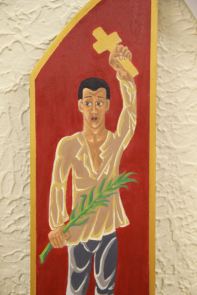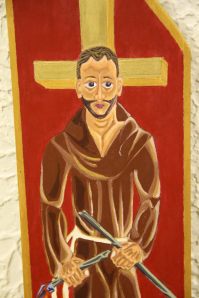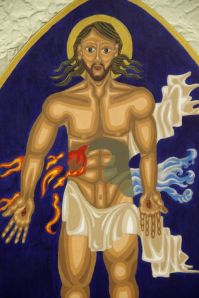
St. Pedro Calungsod of the Visayas
Roughly a year ago, I completed a year-long project. I finally screwed the triptych panels together on the day of my simple profession. It was the result of a year-long prayer experience that depicts my view of God. I made many changes in this project throughout my novitiate year because writing a personal icon evolved with my own prayer experience. Two panels on the left and the right depicts two martyr saints: Spanish OFM missionary to the Philippines, Pedro Bautista and Filipino missionary to the Marianas, Pedro Calungsod. Since their narratives resonate with the persecution of Christians and other defenseless minorities in Syira, Iraq, and Palestine, I find it useful to bring this piece forward. I hope it can offer some helpful insights to those who pray and work for peace.
San Pedro Calungsod
I depicted Pedro Calungsod raising a golden cross and a martyr’s palm. His stance is assertive yet his gaze is certain only insofar as his confidence is drawn from the central triptych. His unbuttoned shirt shows the robust chest of a youth, the first to be struck when he was clubbed to death while using his body to protect Fr. Luis San Vitores, S.J. in the Marianas. With bear feet, grasping hands, outward-bound legs, defenseless Pedro is not holding back as he uses his entire body to proclaim his faith. The cross, symbol of Christian self-emptying love sanctifies his martyrdom. No halo is needed. There is neither fear nor doubt but only trust, which he draws from the central panel, thus reversing the consequences of death.
San Pedro Bautista
Spanish-born friar, Pedro Bautista missioned in the Philippines in the late 1500’s until he was assigned to Japan as a diplomat while working to build churches and schools. The friars’ success in evangelizing to the Japanese proved to be the reason behind their martyrdom. Pedro Bautista was crucified and was stabbed in the neck in Nagasaki. In this panel, Pedro Bautista is depicted in his Franciscan habit. With his neck exposed, he gazes at the central panel. He stands erect and dignified against a golden cross while appearing to break a spear smeared with blood. Everything about this image points to victory. Death has lost its power. Instead of raucous celebration over this victory, Pedro assumes total calm and surrender. No halo but only the cross defines his total gift of self.
Jesus: Relentless, Reckless, Indiscriminate Love
The central panel summarizes the journal entries I never wrote regarding my own view of God but are captured in this image. Jesus nearly naked, runs towards the viewer and is almost ready to jump out of the frame. The fluttering shroud shows the speed and intensity by which Jesus advances towards the viewer; while his hands bearing the mark of his wounds open outwards. His robust and muscular body shows him perfectly healthy and alive which is the complete opposite of his crucified body. Similar to the Divine Mercy image is Chirst’s blood and water which flowed from his side when he was stabbed upon the cross (John 19:34). The difference here is that the blood develops into fire while water surges into waves. Unlike the two Pedros, Jesus has a halo to connote his complete divinity as Himself; he need not draw holiness from any other source. He is placed against a deep blue background to show His power over the universe.
What does this mean to me? This image depicts not only God’s unbeatable generosity but God’s unchanging desire to show mercy to all whom He loves, completely and unconditionally. It shows the absence of fear that awaits those who entrust themselves to God and embrace death even through the victimization of violence. Christ’s readiness to leap out of space and time in order to reach down to our humanity is the perfect gift, driven by total love (John 15:13). The highest ideal of this image is the singular desire of God to be in total fellowship with each of us, with mercy as His only condition. This experience of God is what directed me to my simple profession. I could not say no to someone who broke all the barriers just so I can live and be loved. It’s simply unfathomable to think that because of God’s love, I have life. Yet, it is real.
Relentless, Reckless and Indiscriminate Love: the Life-transforming Seed of Non-violence
Paul persecuted Christians and he claimed that despite his cruelty, he received mercy out of his unbelief (Ratzinger, 2011, p.207). Pedro Calungsod and Pedro Bautista had fared better than Paul in their faith. They would have been the Christians whom Paul had persecuted. No person, even a Christian would naturally yearn for oppression, torture and death under people who behave like Paul. Yet, as Pope Benedict in his second installment of Jesus of Nazareth (2011, p. 212) points out, the good thief notices the complete difference in Jesus; he was non-violent. This drew the good thief closer to God’s friendship and it moved him to accept his fate and surrender himself to God’s mercy. Paul encountered the power of the Prince of Peace through the lives of the Christians he persecuted which culminated in the Road to Damascus. Mercy since then had flooded into his life and consumed all that he was, only to be transformed as an agent of love.
For Christians who are facing the irreversible and unjust sentence of annihilation, we lift our most intimate prayers to the Creator of all things, that our persecuted sisters and brothers be sustained and overtaken by courage and love in the last moments of their human life. For their persecutors, that God’s mercy whose power is beyond our understanding take root into their hearts and effectively inspire them to end all forms of hate and violence against their neighbors. It does not make sense to be grateful for the loss of the innocent lives of martyrs but such has been the fate of Christians since the time of Paul. God’s love wins in the end because it is always relentless, reckless and indiscriminate. We have life because of this and this is our hope.
*This triptych has been presented as a gift to Br. Norbert Bertram, OFM (St. John the Baptist Province).
Source
Ratzinger, J. (2011). Jesus of Nazareth: from the entrance into Jerusalem to the Resurrection. Ignatius Press: San Francisco.


